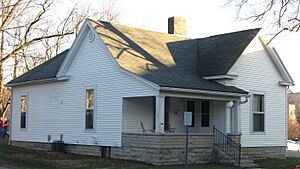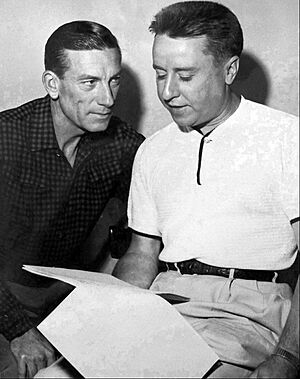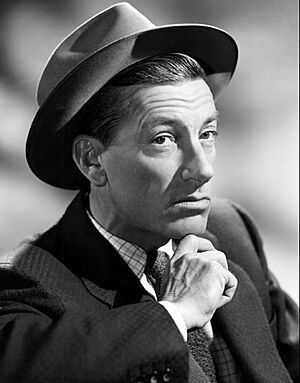Hoagy Carmichael facts for kids
Quick facts for kids
Hoagy Carmichael
|
|
|---|---|
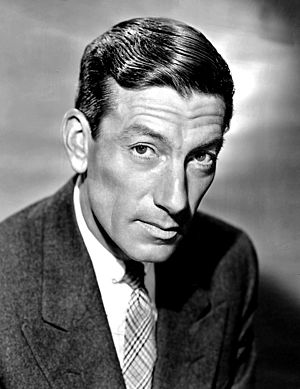
Carmichael in 1947
|
|
| Born |
Hoagland Howard Carmichael
November 22, 1899 Bloomington, Indiana, U.S.
|
| Died | December 27, 1981 (aged 82) |
| Occupation |
|
| Years active | 1918–1981 |
| Political party | Republican |
| Spouse(s) |
|
| Children | 2 |
| Musical career | |
| Genres | Musical films, popular songs |
| Instruments |
|
Hoagland Howard Carmichael (born November 22, 1899 – died December 27, 1981) was an American musician, composer, songwriter, actor, and lawyer. He was one of the most successful songwriters of the 1930s. He was also one of the first singer-songwriters to use new technologies like television and sound recordings.
Carmichael wrote hundreds of songs. Fifty of his songs became big hits. He is famous for writing four of the most recorded American songs ever: "Stardust", "Georgia on My Mind", "The Nearness of You", and "Heart and Soul". He also worked with lyricist Johnny Mercer on songs like "Lazybones" and "Skylark". His song "Ole Buttermilk Sky" was nominated for an Academy Award in 1946. Another song, "In the Cool, Cool, Cool of the Evening", won an Academy Award in 1951. Carmichael also acted in 14 films. He hosted three radio programs and wrote two books about his life.
Contents
Early Life and Education
Hoagland Howard "Hoagy" Carmichael was born in Bloomington, Indiana, on November 22, 1899. He was the first son of Howard Clyde and Lida Mary Carmichael. His parents named him after a circus group called the "Hoaglands." His father worked as a taxi driver and an electrician. His mother, Lida, was a talented pianist. She played piano for silent films and parties to earn money.
Hoagy's mother taught him to sing and play the piano early on. He had some piano lessons in Indianapolis with Reginald DuValle. DuValle was a bandleader known as "the Rhythm King." Other than these lessons, Carmichael did not have much formal music training.
The family moved often because his father's jobs were not steady. Hoagy lived mostly in Bloomington and Indianapolis, Indiana. In 1910, they moved to Missoula, Montana. In 1916, they moved back to Indianapolis. But Carmichael returned to Bloomington in 1919 to finish high school.
To help his family, Carmichael worked manual jobs. He worked in construction, a factory, and a slaughterhouse. This difficult time was made better by playing piano with his mother. He also learned jazz improvisation from DuValle. In 1918, Carmichael earned $5 playing at a dance. This was the start of his music career.
Carmichael's three-year-old sister died in 1918 from a serious illness. This affected him deeply. He later wrote that he vowed to never be poor again.
Carmichael went to Indiana University Bloomington. He earned a bachelor's degree in 1925 and a law degree in 1926. He played piano around Indiana and Ohio with his band, Carmichael's Collegians.
Around 1922, Carmichael met Leon "Bix" Beiderbecke, a cornetist. They became friends and played music together. Beiderbecke introduced Carmichael to Louis Armstrong in Chicago around 1923. Armstrong's music greatly influenced Carmichael's songs.
Carmichael's first recorded song was "Free Wheeling." Beiderbecke's band, The Wolverines, recorded it as "Riverboat Shuffle" in 1924. This song became a jazz classic. Carmichael also wrote "Washboard Blues" and "Boneyard Shuffle."
After law school in 1926, Carmichael moved to Florida. He worked as a legal assistant but failed the Florida bar exam. He returned to Indiana in 1927. He joined a law firm and passed the Indiana bar. But he spent most of his time on music. He realized he "found" melodies rather than writing them.
Music Career Highlights
Carmichael wrote hundreds of songs. Fifty of them became hit records. In his early years (1924–1929), he wrote and played hot jazz music. When he lived in New York City (1929–1936), he wrote songs that could stand alone. Later in California (1936–1981), his songs were mostly instrumentals. Many were written for movies.
Carmichael made hundreds of recordings. He also appeared on radio, television, and in movies. He used new technologies like the microphone. This helped his unique voice, which he called "flatsy through the nose." He was good at selling his songs to others.
Early Successes
On October 31, 1927, Carmichael recorded "Star Dust." This is one of his most famous songs. He played the piano solo himself. New York's Mills Music published it as a piano solo in 1929. It was renamed "Stardust."
The song did not get much attention until 1930. That's when Isham Jones and his orchestra recorded it as a slow, emotional song. It became a big hit. "Stardust" is now a classic song. Many artists have recorded it, including Nat King Cole and Frank Sinatra.
Carmichael gained more fame when Paul Whiteman's orchestra recorded "Washboard Blues" in 1927. Carmichael sang and played piano on that recording.
In 1929, Carmichael moved to New York City. He worked for a company during the day. At night, he wrote music for Hollywood musicals. He met Duke Ellington's agent, Irving Mills. Mills helped him set up recording sessions. Carmichael's first major song with his own lyrics was "Rockin' Chair." Louis Armstrong and Mildred Bailey recorded it.
The 1930s and Beyond
After the stock market crash in 1929, Carmichael's savings went down. But Louis Armstrong's recording of "Rockin' Chair" helped his career. This song became a jazz classic. Carmichael also wrote and recorded "Georgia on My Mind" in 1930. This song also became a jazz and pop classic.
Carmichael joined ASCAP in 1931. He started working for Southern Music Company. The Great Depression made it hard for musicians. Many lost their jobs. Carmichael was lucky to keep his job as a songwriter.
In 1933, he started working with lyricist Johnny Mercer. Their first hit together was "Lazybones." They sold over 350,000 copies of the sheet music in three months. Carmichael and Mercer wrote almost three dozen songs together. This included "In the Cool, Cool, Cool, of the Evening," which won an Academy Award in 1951.
Carmichael also started performing as a solo singer. He described his voice as "the way a shaggy dog looks." In 1935, he started writing songs for Warner Brothers in Hollywood. His first movie song was "Moonburn." Bing Crosby sang it in the 1936 film Anything Goes.
After marrying Ruth Mary Meinardi in 1936, they moved to California. Carmichael hoped to find more movie work. In 1937, he signed a contract with Paramount Pictures. He also started acting in movies. His first movie role was in Topper (1937). He played a piano player and sang "Old Man Moon."
In 1938, Carmichael worked with lyricist Frank Loesser. They wrote "Heart and Soul", "Two Sleepy People", and "Small Fry". "Heart and Soul" was in the movie A Song Is Born (1938). Later, a simpler version became a popular piano duet for children.
The 1940s: Movies and Radio
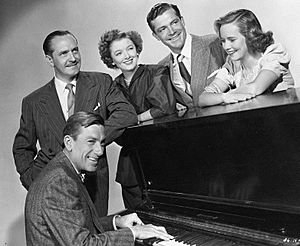
During World War II, Carmichael wrote patriotic songs. These included "My Christmas Song for You" and "Cranky Old Yank."
In 1941, he and Johnny Mercer wrote "Skylark." Many artists have recorded this song. His 1942 song "I'm a Cranky Old Yank" had a very long title. It was listed in the Guinness Book of Records for its length.
Carmichael acted in 14 movies. He usually sang one of his songs in each film. In 1944, he played Cricket in To Have and Have Not. He sang "Hong Kong Blues" and "The Rhumba Jumps." In The Best Years of Our Lives (1946), he taught a veteran to play "Chopsticks." He also performed "Lazy River." In Canyon Passage (1946), he composed songs like "Ole Buttermilk Sky."
Carmichael's career as a recording artist was strongest in the mid-1940s. He recorded for Decca Records. He also hosted music shows on the radio. He wrote his first book, The Stardust Road, in 1946.
The 1950s and Later Years
In the 1950s, music changed. Rock and roll became popular. Carmichael's songwriting slowed down, but he still performed. He hosted Saturday Night Review on television in 1953. He also acted in the TV series Laramie (1959–63).
His marriage to Ruth ended in 1955. Carmichael also wrote songs for children, like "The Whale Song."
Ray Charles's famous version of "Georgia on My Mind" came out in 1960. It was a huge hit. In 1961, Carmichael was in an episode of The Flintstones. Even as the Beatles became popular, Carmichael still earned a lot of money from his old songs.
Carmichael's second book, Sometimes I Wonder, was published in 1965. He retired from music and enjoyed golf and coin collecting. He had homes in Los Angeles and Rancho Mirage, California.
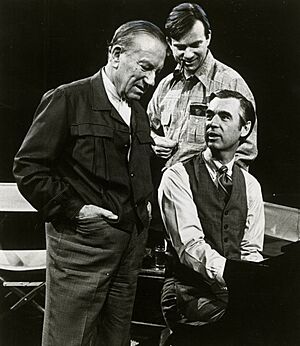
In his later years, Carmichael appeared on the PBS show Hoagy Carmichael's Music Shop. He also appeared on Fred Rogers's show Old Friends, New Friends in 1978. He married actress Dorothy Wanda McKay in 1977.
Carmichael received several honors. He was inducted into the Songwriters Hall of Fame in 1971. Indiana University gave him an honorary music degree in 1972. In 1979, the Newport Jazz Festival celebrated his 80th birthday with a concert. He even performed a new song called "Piano Pedal Rag."
Hoagy Carmichael died of a heart attack on December 27, 1981, at age 82. He is buried in Rose Hill Cemetery in Bloomington, Indiana.
Political Views
Carmichael supported the Republican Party throughout his life. He voted for Wendell Willkie in 1940 and Barry Goldwater in 1964.
Legacy and Honors
Hoagy Carmichael is seen as one of the most successful songwriters of the 1930s. He was a pioneer in using new media like television and sound recordings. He recorded his own songs and provided music for many other artists. His work includes hundreds of songs, many of which are still popular today.
Music experts describe Carmichael as a very productive songwriter. His work appeared in many Hollywood films. "Stardust" is one of his most recorded songs. He was known for his "catchy, often jazz-infused, melodies" and "nostalgic lyrics." These songs were very popular, especially with help from mass media and other entertainers.
In 1986, Carmichael's family gave his archives, piano, and other items to Indiana University. The university created a Hoagy Carmichael Collection and a special room to display his items.
Carmichael and Johnny Mercer won an Academy Award for "In the Cool, Cool, Cool of the Evening" in 1951. His song "Ole Buttermilk Sky" was also nominated for an Oscar in 1946. His 1927 recording of "Star Dust" was added to the Grammy Hall of Fame. It was also chosen for the National Recording Registry at the Library of Congress in 2004.
Carmichael received a star on the Hollywood Walk of Fame in 1960. He was one of the first ten people inducted into the Songwriters Hall of Fame in 1971. In 2007, he was inducted into the Gennett Records Walk of Fame in Richmond, Indiana.
There is an Indiana state historical marker for Carmichael in Bloomington. A bronze sculpture of him was also placed at Indiana University in 2008.
"Georgia On My Mind," written by Carmichael and Stuart Gorrell, is the official song of the U.S. state of Georgia.
Carmichael also appeared as a Stone Age version of himself in The Flintstones. He sang "The Yabba Dabba Doo Song" in the episode.
Filmography
| Year | Title | Role | Notes |
|---|---|---|---|
| 1937 | Topper | Piano Player | Uncredited |
| 1944 | To Have and Have Not | Cricket | |
| 1945 | Johnny Angel | Celestial O'Brien | |
| 1946 | Canyon Passage | Hi Linnet | |
| 1946 | The Best Years of Our Lives | Uncle Butch Engle | |
| 1948 | Night Song | Chick Morgan | |
| 1949 | Johnny Holiday | Himself | |
| 1950 | Young Man with a Horn | Smoke Willoughby | |
| 1952 | The Las Vegas Story | Happy | |
| 1952 | Belles on Their Toes | Thomas George Bracken | |
| 1955 | Timberjack | Jingles | |
| 1959-1960 | Laramie | Jonesy | 31 episodes |
| 1961 | The Flintstones | himself (voice) | "The Hit Songwriters" |
| 1965 | The Man Who Bought Paradise | Mr Leoni | TV movie |
Selected Songs
| Year | Song | Lyrics by |
|---|---|---|
| 1924 | "Riverboat Shuffle" | Carmichael, Dick Voynow, Irving Mills, Mitchell Parish |
| 1925 | "Washboard Blues" | Carmichael, Fred B. Callahan, Irving Mills |
| 1928 | "Stardust" | Mitchell Parish |
| 1929 | "Rockin' Chair" | Carmichael |
| 1930 | "Georgia on My Mind" | Stuart Gorrell |
| 1931 | "Come Easy Go Easy Love" | Sunny Clapp |
| 1931 | "(Up a) Lazy River" | Carmichael and Sidney Arodin |
| 1932 | "New Orleans" | Carmichael |
| 1932 | "Daybreak" | Carmichael |
| 1932 | "In the Still of the Night" | Jo Trent |
| 1933 | "Lazybones" | Carmichael and Johnny Mercer |
| 1933 | "One Morning in May" | Mitchell Parish |
| 1936 | "Little Old Lady" | Carmichael and Stanley Adams |
| 1936 | "Lyin' to Myself" | Stanley Adams |
| 1936 | "Moonburn" | Edward Heyman |
| 1937 | "Old Man Moon" | Unknown |
| 1937 | "The Nearness of You" | Ned Washington |
| 1938 | "Heart and Soul" | Frank Loesser |
| 1938 | "Small Fry" | Frank Loesser |
| 1938 | "Two Sleepy People" | Frank Loesser |
| 1938 | "I Get Along Without You Very Well (Except Sometimes)" | Jane Brown Thompson |
| 1939 | "Hong Kong Blues" | Carmichael |
| 1940 | "Can't Get Indiana Off My Mind" | Robert DeLeon |
| 1940 | "I Walk with Music" | Johnny Mercer |
| 1940 | "Way Back in 1939 A.D." | Johnny Mercer |
| 1941 | "Skylark" | Johnny Mercer |
| 1941 | "We're The Couple In The Castle" | Frank Loesser |
| 1942 | "Baltimore Oriole" | Paul Francis Webster |
| 1942 | "The Lamplighter's Serenade" | Paul Francis Webster |
| 1943 | "Old Music Master" | Johnny Mercer |
| 1945 | "Billy-a-Dick" | Paul Francis Webster |
| 1945 | "Doctor, Lawyer, Indian Chief" | Paul Francis Webster |
| 1945 | "Memphis in June" | Paul Francis Webster |
| 1946 | "Ole Buttermilk Sky" | Carmichael and Jack Brooks |
| 1951 | "Who Killed the Black Widder" | Hoagy Carmichael, Janice Torre & Fred Spielman |
| 1951 | "In the Cool, Cool, Cool of the Evening" | Johnny Mercer |
| 1951 | "My Resistance Is Low" | Harold Adamson |
| 1952 | "Watermelon Weather" | Paul Francis Webster |
| 1953 | "Ain't There Anyone Here for Love?" | Harold Adamson |
| 1953 | "When Love Goes Wrong (Nothin' Goes Right)" | Harold Adamson |
Discography
- 1944–45 V-Disc Sessions (Totem, 1985)
- At Home with Hoagy (Take Two, 1982)
- Hoagy Carmichael (RCA International, 1981)
- Hoagy Carmichael: Old Buttermilk Sky (Collector's Choice, 1999)
- Hoagy Sings Carmichael (Pacific Jazz, 1957)
- Star Dust, 1927–32 (Historical, 1982)
- The Stardust Road (MCA, 1982)
- Stardust and Much More (Bluebird, 1989)
- Stardust Melody: Carmichael and Friends (RCA, 2002)
- The Classic Hoagy Carmichael (Indiana Historical Society and the Smithsonian Institution's Collection of Recordings, 1988)
- The Hoagy Carmichael Songbook (RCA Bluebird, 1990)
- Stardust: The Jazz Giants Play Hoagy Carmichael (Prestige, 1997)
- Mr. Music Master (Naxos, 2002)
- Hoagy Carmichael in Person 1925–1955 (Avid, 2006)
- The First of the Singer Songwriters (JSP, 2008)
Tributes
- Stark Reality: The Stark Reality Discovers Hoagy Carmichael's Music Shop (1970)
Other Published Works
Carmichael wrote two books about his life. They were later combined into one book:
- The Stardust Road (1946)
- Sometimes I Wonder: The Story of Hoagy Carmichael (1965)
See also
 In Spanish: Hoagy Carmichael para niños
In Spanish: Hoagy Carmichael para niños
- Martha Carmichael Clayton, his sister
- The Archives of Traditional Music, Indiana University


